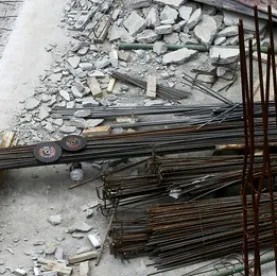This Alert addresses potential contractual relief for construction projects impacted by COVID-19. Many projects are now suddenly stopped, not starting, or at least subject to slowdowns and delays caused by COVID-19. The impacts may arise from supply chain disruptions, state or local government stay-in-place orders,[1] and workforce disruptions on every level — design, field construction, manufacturing, and inspection. Even without stay-in-place orders, personnel may be sick or stay home to avoid exposure. The cost to the construction industry and to your projects will likely be staggering.
Now is the time to pull out your contract (contractors and project owners alike) and consider how the contract’s delay, time extension, or force majeure clauses, as well as other contract clauses and legal theories, allocate this unusual risk between the parties. Are there possible liability clauses, issues, and defenses that you are overlooking? This Alert looks at how typical construction contracts allocate risk for COVID-19, as well as how US law treats relevant clauses, including potential relief outside the contract terms.
The term “force majeure” is French for “superior or irresistible force.” In US common and civil law, the term commonly refers to natural and unavoidable catastrophes that affect contract performance. Force majeure contract clauses allocate the risk of such events. Most standard US construction contracts (e.g., American Institute of Architects and ConsensusDocs), do not specifically use the term “force majeure.” The same is true for federal government and most state and local public construction contracts. Instead, relief for force majeure events under most US construction contracts is addressed in delay and time extension remedial clauses. For convenience, we will use the term “force majeure” to cover all such remedial clauses.
As you read on, consider these critical questions in relation to your projects as you plan near-term actions and also ponder long-term strategy and potential consequences:
-
Does the COVID-19 disruption constitute a force majeure event under your contract?
-
Is epidemic, pandemic, or illness specifically identified in your force majeure clause?
-
If not, does COVID-19 fall under some of the other events often referenced in force majeure clauses, such as an “act of God,” a “natural disaster,” or just something beyond the contractor’s control?
-
Most force majeure clauses allow for schedule extensions without compensation. But does your force majeure clause support compensation as well as a time extension? Allow one or both parties to terminate the contract? Provide for some other form of contract relief or contract modification?
-
Does the law that controls your contract (federal, state, or international) reinforce or limit how force majeure clauses may be applied?
-
Does that controlling law suggest avenues of relief outside a force majeure clause, such as commercial impracticability?
-
What should you be doing now to reserve your rights and document your position?
1. What constitutes a force majeure event?
Generally speaking, a force majeure event may exist if the event is unforeseeable and outside the contractor’s control. COVID-19 certainly seems to be that. But whether a court or arbitration panel agrees with that general assessment will be revealed only as claims for relief are resolved or otherwise work their way through the courts and formal dispute procedures.
While uncertainty lies ahead, key factors in determining whether a force majeure clause offers relief for COVID-19 impacts will likely include (1) whether the language in the force majeure clause specifically references the event as beyond the parties’ control; (2) whether the force majeure event was foreseeable; and (3) whether the force majeure event caused the party’s nonperformance.
At first glance, COVID-19 might check these boxes. But this is just the first step. It ultimately will depend on the trier-of-fact’s evaluation of the following:
-
The three factors listed above
-
Your contract language
-
The facts, the facts, the facts! (i.e., what actually transpired on the project)
-
The relation between COVID-19 and the specific relief sought
In considering the contract language, if your force majeure clause contains a very specific list of events (e.g., “epidemic,” “pandemic,” “outbreak of disease”) or other similar terms, then the COVID-19 pandemic would almost certainly fit within that clause. But note that “epidemic” and “pandemic” are not technically the same thing. And some courts will strictly construe the precise language of force majeure clauses to exclude events that are not specifically identified.
To that end, what if your contract limits force majeure events specifically to events involving nature (e.g., “severe floods” or “earthquakes”)? In that case, courts may be less likely to find that the parties intended that clause to cover the COVID-19 pandemic.
Other force majeure clauses may be a hybrid of the specific and broad forms and include a catchall provision meant to cover additional potential scenarios other than specific events. In these instances, some courts have held that common law notions of force majeure, such as unforeseeability, should be considered when a party has not protected itself by specifically listing an event in the force majeure clause. There, it may come down to a question of what the parties contemplated and if the parties voluntarily assumed the risk of COVID-19 (or, perhaps less specifically, a general pandemic).[2]
Your contract could also reference “acts of God” as an excusable delay. But the definition of “acts of God” varies from state to state. Some states have found that acts of God include wars, riots, hurricanes, floods, epidemics, and natural disasters. COVID-19 is more likely to be covered here. However, other states have more narrowly described an “act of God” as something caused by nature. Therefore, identifying the controlling law and how that particular state has used the term “act of God” is important.
Further, if you are looking to invoke a force majeure clause, it is critical to follow the contractual requirements for doing so. Note the form and substance of any required notice, as well as associated notice time limits. Many states demand strict compliance with such notice requirements, and a failure to adhere to even just one aspect can render a claim or extension request void.
But even if there is no timing requirement, it is better to communicate, sooner rather than later, even if on a preliminary basis and with caveats. You do not want to appear to be sandbagging on such a serious issue. Beyond technical notice requirements, such communications can help maintain good relations in difficult circumstances and keep everyone informed to help mitigate impacts and limit miscommunications.
When providing formal notice or otherwise articulating a basis for relief from COVID-19 impacts, contractors should attempt to cite to contract terms or legal theories, but also be wary of pigeonholing themselves too quickly and potentially cutting themselves off from relief under other clauses and theories. Owners must also exercise reciprocal caution and diligence in responding.
Most force majeure clauses allow only for an extension of time, and not a corresponding price adjustment. But COVID-19 will almost certainly cause the cost of performance to increase. A contractor reacting too quickly and categorically may unnecessarily limit itself to a time extension. Conversely, an owner that adamantly denies a time extension without compensation under a force majeure clause may find itself defending under another clause or legal theory that allows for contractor compensation.
2. Does COVID-19 constitute an excusable event under form construction contracts?
Standard form construction contracts, such as AIA and ConsensusDocs, do not have specific force majeure clauses. These contracts do however contain excusable delay clauses that could likely be applied to COVID-19 impacts and delays. The relief offered in these contracts could be a time extension and for either party the opportunity to terminate the contract. But other form documents, like some versions of the Fédération Internationale des Ingénieurs-Conseils (FIDIC), contain explicit force majeure clauses.
AIA Forms Addressing Excusable Delays
The AIA A201-2017 General Conditions form (AIA form) does not use the term “force majeure”; however, Section 8.3.1 (“Delays and Extensions of Time”) includes broad catchall terminology that provides several examples as the basis for time extensions for events outside the contractor’s control, and may very well cover COVID-19 impacts:
If the Contractor is delayed at any time in the commencement or progress of the Work * * * (3) by labor disputes, fire, unusual delay in deliveries, unavoidable casualties, adverse weather conditions documented in accordance with Section 15.1.6.2, or other causes beyond the Contractor’s control; * * * or (5) by other causes that the Contractor asserts, and the Architect determines, justify delay, then the Contract Time shall be extended for such reasonable time as the Architect may determine (emphasis added).
COVID-19 impacts could fall into several of these categories in this clause of the AIA form, such as “unusual delay in deliveries,” “unavoidable casualties,” and “other causes beyond the Contractor’s control.”[3]
AIA — Termination and Suspension of Work
Article 14.1.1.2 (“Termination or Suspension of the Contract”) of the AIA form gives the contractor the right to terminate the contract if the work is stopped for a period of 30 consecutive days through no fault of the contractor for “An act of government, such as declaration of national emergency, that requires all work to be stopped.”
Relying on this language, a contractor may be able to terminate the contract based on a lengthy work stoppage required by a stay-in-place or other health order that prohibits construction or an order that has that direct net effect. If invoked, the result is effectively a termination for convenience; the AIA form provides the contractor the right to recover payment for work performed, reasonable overhead and profit on work not executed, and costs incurred by reason of such termination.
Flipping the script, an owner could invoke the suspension or termination clause for convenience explicitly set forth in the AIA form. If the contract was suspended for convenience, a contractor would be entitled to an increased adjustment to the contract value, including profit (Article 14.3, “Suspension by the Owner for Convenience”). If the contract was terminated for convenience, the owner would still be on the hook for paying the contractor for work properly executed; costs incurred by reason of termination, including costs attributable to termination of subcontracts; and any other contractual termination fees (Article 14.4, “Termination by the Owner for Convenience”).
ConsensusDocs Expressly Provides Relief for “Epidemics”
The ConsensusDocs standard forms almost certainly will allow contractors relief from COVID-19 delays. The ConsensusDocs 200-2017 Standard Agreement between Owner and Contractor specifically identifies “epidemics” as an excusable delay in Article 6.3 and gives the contractor the right to an equitable extension of time under the contract. Article 6.3 goes on to identify numerous examples of causes beyond the control of contractors, including “adverse governmental actions” and “unavoidable…circumstances.”[4]
ConsensusDocs — Termination and Suspension of Work
As to suspension or termination in ConsensusDocs, contractors and owners have similar rights and remedies as provided under the AIA form. The 200 Standard Agreement contemplates “national emergency or other governmental act” as a basis for the contractor to terminate and entitles the contractor to recover costs for executed work, and for proven losses, costs, or expenses, including demobilization costs, plus overhead and profit on work not performed (Article 11.5, “Adjustment and Settlement of Insured Loss”). Be sure to pay attention to your notice requirements as well as the owner’s right to cure in invoking such clauses.
If the owner elects to invoke a termination for convenience provision under Article 11.4 of the 200 ConsensusDocs form, the contractor could still recover (a) payment for work performed to date, including overhead and profit; (b) demobilization costs and costs incurred from termination, but not overhead and profit on work not performed; (c) reasonable attorneys’ fees and costs related to termination; and (d) a premium — if initially agreed to by the parties.
DBIA Expressly Provides Relief for Epidemics Under the Definition of Force Majeure
If you are working on a design-build project using a standard Design-Build Institute of America (DBIA) form that incorporates the Standard Form of General Conditions (DBIA 535, 2010 version), the contractor will likely be entitled to a time extension for COVID-19 impacts but not an adjustment to the contract price. The DBIA forms define force majeure events to include events beyond the contractor’s control, including “epidemics.” However, and unique from other standard contract forms, Section 8.2 of the DBIA form (“Delays to the Work”) expressly carves out force majeure events and prohibits a contractor from contract price adjustments for force majeure events, but allows such adjustments for other changes such as differing site conditions and hazardous conditions.
3. What do federal, state, and local contracts say — excusable delay?
Federal procurement contracts do not use the term force majeure. Instead, they rely on time extension clauses for delays outside the contractor’s control. If you are working under a federal contract, your contract likely includes FAR 52.249-14 (“Excusable Delays”), which lists specific examples of excusable events of delay, including “epidemics” and “quarantine restrictions,” which should provide a contractor a time extension on the project for COVID-19 delays. If you are currently working on a federal project, check your contract to ensure FAR 52.249-14 is referenced and included. Also be sure to document all delay impacts and underlying facts to best present your schedule extension request to the contracting officer.
Similarly, most state and local procurement contracts do not use the term force majeure. As a result, your best bet is to analyze COVID-19 impacts and to review your excusable delay provisions, which should allow for time extensions.
4. FIDIC international contracts
Although the majority of this Alert focuses on domestic force majeure issues, international form contract documents also address force majeure. For example, the 1999 edition FIDIC standard contracts contain provisions specifically identifying and defining force majeure as an exceptional event beyond the parties’ control that was not reasonably foreseeable, could not reasonably have been avoided, and was not attributable to either party. The clause then provides a nonexhaustive list of events that may qualify as a force majeure event. Interestingly, the clause does not reference “epidemic” or “pandemic.” It appears likely, however, that an international tribunal would find that the COVID-19 pandemic is a force majeure event. The 2017 edition FIDIC contracts remove specific reference to the term “force majeure,” and replace it with “exceptional event.” Although the provision itself remains similar (but not identical) to the 1999 edition, its retitling emphasizes that a force majeure event must be “exceptional,” not just unusual. Further, causation is an important aspect of the FIDIC framework: Did the event really affect performance? If so, how? And as with US law governing force majeure events, parties still have an obligation to mitigate the impacts caused by these events.
5. What if your contract does not have a force majeure clause?
If a contract does not contain an express force majeure clause or other similar language addressing “acts of God” or unanticipated delays beyond the contractor’s control, there is still hope for the contractor, and the owner is not necessarily off the hook. Another angle to consider is the application of the common law doctrine of commercial impracticability. While not all states recognize impracticability as a common-law defense, both the Uniform Commercial Code (UCC) and Restatement (Second) of Contracts have recognized the defense, which could be applied to COVID-19 delays.
UCC and Restatement (Second) of Contracts — Impracticability Defense
In contracts for the sale of goods, the UCC provides some protection for a seller whose performance has been made impossible due to unforeseen circumstances. UCC §2-615(a) states that delays may be excusable if performance has been made “impracticable” by an event outside the seller’s control. Similarly, the Restatement (Second) of Contracts recognizes the defense of commercial impracticability in Section 261 where the event causing the party’s performance to be impracticable was not the contractor’s fault. While the contract should be the first stop in evaluating whether COVID-19 impacts may constitute grounds for relief, there may be legal theories outside the four corners of the contract that impact liability.
Change in Law
In addition to the defense of commercial impracticability, consider whether a change-in-law provision in your contract is another potential remedy (e.g., adjustment in price, adjustment in time, termination of the contract) in the event that a governmental order or change in applicable law makes contract performance impracticable or impossible. COVID-19 has resulted in numerous governmental laws, orders, and regulations, many of which may impact contract performance, and your contract may provide an additional basis of relief in such a scenario.
6. Recommended COVID-19 force majeure action items
As addressed above, it is important to understand your company’s contracts as COVID-19 impacts continue to unfold. We recommend several key actions that you should immediately take to properly evaluate and plan for a force majeure event:
-
Review your contract. Identify key clauses implicated by COVID-19. What relief are you entitled to under these clauses? What do you need to do to preserve your rights (e.g., required notice) to claim this relief, in terms of notice and other documentation?
-
Identify specific impacts and document the impacts. What delays is your company facing? How are your downstream vendors and suppliers affected? How will that impact your company down the road? What notices should you be sending out, if any? Answer these questions and document impacts as they emerge and evolve. It is critical to document all delays and how the delays were caused.
-
Formulate a plan. All parties have a legal duty to mitigate COVID-19 impacts. Identify these impacts and the steps you can take to lessen their effect. Are there other scopes of work under the contract you could be performing despite all the governmental shutdowns? Maintain communication with clients, contractors, suppliers, etc. Monitor updates to legislation and other governmental orders, which continue to evolve and vary state to state.
-
Communicate to inform, not to agitate. Formal notices and other written and verbal communications among the parties should be precise, factual, and without emotion or hyperbole. The point is to inform while also satisfying technical notice requirements. Attacking the other side and putting them on the defensive may yield a short term tactical advantage, but it can also have the opposite effect and make it more difficult to mitigate or resolve anything in both the near term and long term. Think of how your communications will be received by the other party and how they will look to a third party (judge, jury, or arbitrator) in a worst-case scenario. Will you appear reasonable, businesslike, and looking for solutions, or just the opposite? It matters.
[1] See Jones Walker March 2020 Client Alert regarding shelter-in-place orders for more details, available at: https://sites-communications.joneswalker.com/20/1389/landing-pages/impact-of-state-and-local--stay-at-home--or--shelter-in-place--orders-on-construction-in-al--fl--ga--la--ms--and-tx---lp-(fwd).asp?sid=blankform.
[2] To that point, and in particular with contracts entered into since COVID-19, the new awareness of the threat of a viral pandemic may change the landscape of how the courts review contracts going forward, including the parties’ expectations and assumptions of risk.
[3] Very similar language is included in the AIA A201-2007 General Conditions form as well.
[4] ConsensusDocs 410, the Standard Design-Build Agreement and General Conditions for an Owner and Design Builder, uses nearly identical language and terminology as the owner/contracting agreement.





 />i
/>i

